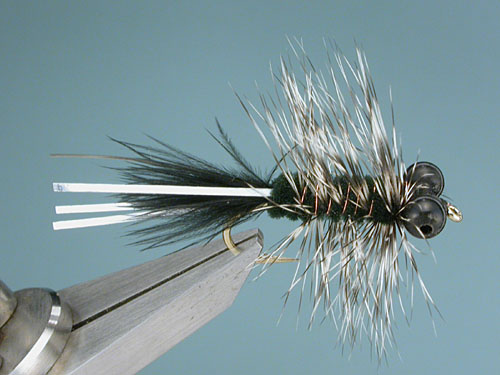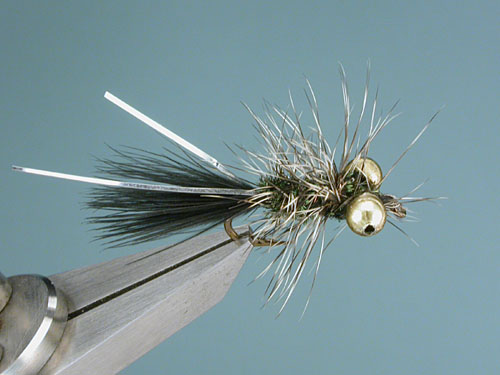Black
Buggers are my go-to fly. I've caught smallmouth that ranged
from little to “he must be exaggerating”. And I have caught
Bluegill from the size of a quarter to “I know he's
fibbing”. Whenever things get slow it's my “old reliable”.
In some cases it is the only fly I use.
|
Story and Fly By
Dan Gober, Fulton,
New York |
|
I tied
my first fly when I was fourteen. Then after a short break I
started tying for real at forty five. Been at it for the
last fourteen plus years. I live in Central New York near
Oswego. I fish the Oswego River and local streams for
Smallmouth, Bluegill and whatever else is there. |
|
I
started out tying buggers by following a recipe from a book, palmering
hackle forward over a chenille body. But most of my buggers
fell apart; the hackle came loose and floated on the
surface. Once in a while I caught fish, maybe twice in a
while. Luckily, a few small changes in the way
I tied them solved all my problems.
First;
rather than tying in the hackle at the back of the shank, I
saw somewhere a technique where the hackle was tied in by
the butt, at the front of the hook. After the body was
created by wrapping chenille in the classic fashion, from the back to the front, the
hackle was then palmered rearward to the end of the shank.
Fine copper wire was used to tie down the hackle tip and
then wrapped forward as a rib, cross-wrapping the palmered
hackle stem. This locked the hackle in place and kept it
from breaking or coming loose.
I use a
lot of buggers, so I was fortunate to find a lifetime
supply of copper wire at a yard sale. Keep you eyes
open. You might get lucky,
too.
Another ribbing option in lead wire. I have used fine
lead wire to rib size 8 buggers to give them a little extra
weight. The day I first tried this I caught the “he's got to
be lying” smallmouth. That day I caught half a dozen 2 plus pounders and one I wish I had a camera for.
Second;
I read somewhere that beadchain eyes make deadly buggers.
What I have found is that by tying the eyes on top of the
shank, they cause the fly to ride with the hook pointing up, less snags. The
eyes also give the fly a nice slow fall, very close to the
way a leech swims to the bottom. Some say it creates a
jigging action. Whatever it does, Smallmouth love it.
Third, I
found that by adding a flash-tail I caught more fish. A
couple of pieces of Flashabou is all that is needed. The little bit of
flash attracts a lot of strikes.
--Dan
Gober, February 2006
|
Black "Bead-eyed" Bugger
(small!) |
|

Photo by Peter Frailey
|
Tying
Sequence:
Hook: Sizes 8 to 14, 3xl or 4xl
Thread: Black, 140 denier
Eyes: Bead chain
Tail: Marabou plus 1 or 2 strands flashabou
Rib: 36 gauge copper magnet wire
Body: Black chenille
Hackle: Black or grizzly saddle hackle |
|
|
Black "Bead-eyed" Bugger
(smaller!) |
|

Photo by Peter Frailey
|
Tying
Sequence:
Hook: Sizes 8 to 14, 3xl or 4xl
Thread: Black, 70 denier
Eyes: Bead chain
Tail: Marabou plus 1 or 2 strands flashabou
Rib: 36 gauge copper magnet wire
Body: Peacock herl
Hackle: Black or grizzly saddle hackle
Tying
Tip:
The fly above was
completed by tying in the herl, copper wire and
hackle at the rear of the shank, and twisting
them together to make a rope. Wrap the rope
forward, as one. |
|
|